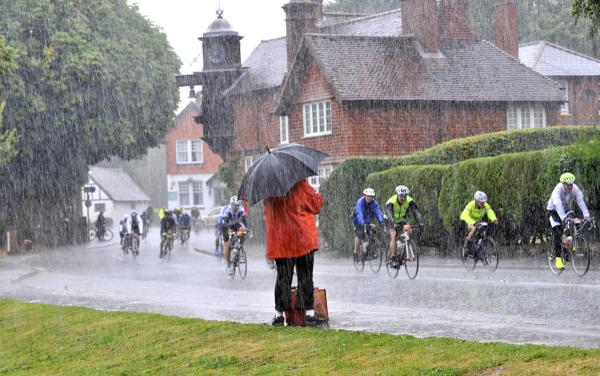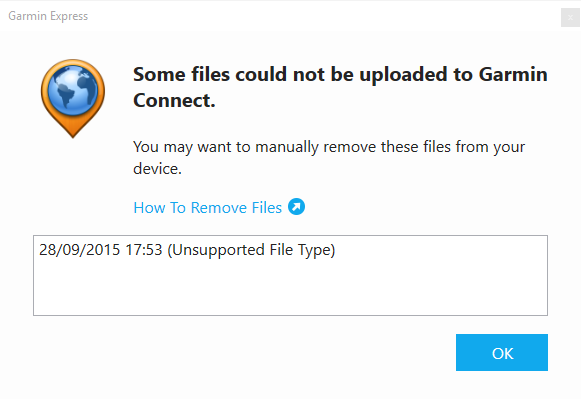This content is 10 years old. I don't routinely update old blog posts as they are only intended to represent a view at a particular point in time. Please be warned that the information here may be out of date.
East London, 6.30am, and I’ve somehow managed to miss a great big sign saying “to the start” as I make my way to the Ride London-Surrey 100. Luckily, there were enough other cyclists around for me to realise the error of my ways and get back on track. A few minutes later I was taking dodgy “start-line selfies” whilst checking the weather forecast and chatting to fellow riders queuing up next to the Lea Valley Velopark, waiting for our wave to start the slow procession towards the start line.
I’d been looking forward to this sportive for a while – I realised how lucky I’d been to get a ballot place – and, with my London-Paris and Holme Moss challenges under my belt, I’d pushed my training up to 100 miles. This was supposed to be special: ride out from the Olympic Park, tackle the Surrey Hills, and finish up on the Mall. Sadly, I learned on the start line that the route had been cut to 86 miles through the removal of Leith and Box Hills because to safety concerns with ex-hurricane “Bertha” coming through. I wasn’t very happy: my second journey to East London in three days (first time to “register” for the event, in what seems to be an elaborate ruse to guarantee that at least 24,000 people visit the Prudential Ride London Cycle Show) and after a 04:15 start to get myself to the start and this was not what I wanted to hear. In the end though, I have to admit that 86 miles in the wind and the rain was plenty. Last Sunday was one of those days when rule 5 definitely applied.

As a predicted slow rider (I think I originally said about 7.5 hours, before revising to 6.5 later), I started at 08:10 and with only 20 minutes to the back of the race I was conscious that the broom wagon could be upon me at any time. I had 26 miles to cover to the first hub before 10:30 – which should have been a doddle – but I decided to crack on anyway. The first couple of miles were lined with people waiting for their friends with different start times and a surprisingly high number of punctures (thankfully I didn’t suffer any) but I was enjoying my ride as I flew down the East Cross Route towards Docklands. A former motorway (now the A12), closed to all traffic except cyclists and I was averaging just shy of 30kph (not bad for me). Along Aspen Way, into the Limehouse Link, onto The Highway. I was buzzing. Past the Tower of London (poppies look amazing) and towards the Embankment. Running red lights (legally) through central London (with a spectator using a traffic cone as a megaphone) and on out to the west, watching lines of no-doubt extremely annoyed motorists on the eastbound A4 as we had the whole of the westbound carriageway to ourselves as far as Hammersmith.
By now the weather was deteriorating and the ride was marginally less fun but I was making good progress as I stopped to take on (and release) fluids at a drinks station near Chiswick. As we hit Richmond Park I was making a steady pace up the hills but then came the rains. Not just a shower, but monsoon rains, the likes of which are rarely seen in England. After taking shelter for a while I decided there was nothing for it but to get back on, only to be reduced to a standstill, and then walking pace, whilst an ambulance crew dealt with an accident. Hopefully the poor soul involved was OK – as it was around 40 minutes before I was on the move again – and we crept into into a flash-flood-hit Kingston after which I suspect my bottom bracket may now be full of smelly water.
At this point the lead riders were coming back through on their final stretch back to London. I was sorely tempted to join them but stuck with it, under flooded railway bridges and out over the Thames to the first hub. The time? 10:30! The broom wagon was due now but there were still thousands of riders coming through.
Setting off again, I witnessed another accident between Weybridge and Brooklands as the rider a short distance ahead lost traction and hit the road. I stopped and called an ambulance whilst his fellow riders kept him safe and, after the St John Ambulance guys arrived I set off again. On into deepest Surrey, the next section was a real slog into the prevailing wind and I was wondering just how far out of London we would keep on heading before the course turned north east again. At one point a chap said “follow me – you’ve been making good pace and I’ve been on your wheel for a couple of miles” but I couldn’t manage his speed and I had to let him drop me. Eventually, the sun started to appear as we climbed to Newlands Corner and, hard as the climb felt, I was glad to hear one of the spectators call out “it’s a long way to the finish mate, but you’re nearly at the top of this hill and it’s downhill from there”. What a star!
Actually, that was the wonder of it all. Despite the wind and the rain (and the reputation that Surrey has for hating cyclists who clog up the roads on a weekend), loads of people had turned out to watch 20,709 cyclists ride past their front door and were cheering us on in our “two-wheeled version of the London Marathon”. “Come on Olney Multisport” I heard (the team name on my kit that day), “Sunshine ->” I read on one placard, whilst the next one said “the weather may be crap but you’re doing great!”. Clearly not making great time, I didn’t stay long at Newlands Corner because the broom wagon was due again and I set of down the hill, only to stop to retrieve my rain jacket which had come out of my pocket and was wrapped around my rear hub. Maybe if I paid less attention to rules 29 and 31 I might have room in my pockets for layers of clothing removed due to changes in weather conditions!
Now heading east, and riding in sunshine, things were looking up. We passed the Leith Hill diversion and then a couple of Police motorbikes came past me. Unfortunately I didn’t realise why they were there and, part way down the next hill, under trees, on a wet slippery road I heard shouts of “slow down, accident ahead”, as I skidded, caught the bike, skidded again, crossed double solid white lines and hit the road, sliding along on my left side thinking “please don’t scratch my bike” whilst I tested the “tarmac resistance factor” of my kit. Luckily for me, I only suffered superficial damage (so did the bike, with scratched brake lever, pedal, and rear skewer – all easily fixed) and was quickly back on my feet. I wish I’d had the manners to properly thank the lady rider behind who’d checked I was OK but, in the heat of the moment I’d said a quick “I’m fine thanks” and jumped back on, with the biggest damage being to my pride. And I’d like to think my “luck” in not being badly hurt coming off at what appears to have been about 42kph was karma for stopping to help someone else earlier…
On through Dorking and up the A24 to Leatherhead, bypassing Box Hill, it was actually getting quite warm. For the first time all day I was down to my normal summer kit (removing the arm warmers and tights that had probably saved my arms/legs from gravel rash earlier) and I was keen to get through the miles. At Oxshott, I spotted a pub with an all day BBQ to celebrate the ride coming past (one of many joining in the celebrations) and contemplated a beer but pushed on. Shortly afterwards, I pulled over for a snack and another one of the wonderful spectators called out “have you got a puncture mate?” I didn’t, but I thanked him for his kindness, as he offered a mobile puncture repair service (including a track pump in his rucksack)! Once again, the generosity and support from people on the roadside had really amazed me – clearly not everyone views this annual event the way some journalists do.
I’ve mentioned the spectators but the volunteers who worked as marshalls and other roles to run the event were superb. I’ve done something similar myself, as a volunteer marshall (a Tourmaker) for the 2014 Tour de France Grand Départ and it was amazing but we had sunshine and professional riders – these guys had torrential rain, howling winds, and thousands of amateur cyclists to look after. That didn’t stop them from encouraging us, being a smiling face at the roadside, and otherwise helping out. Sure, the professional stewards (orange jackets) looked bored but the volunteers were fantastic and really helped to build the atmosphere of the event.
[youtube=https://www.youtube.com/watch?v=fdvIwmez7v0]
After a blitz back through Kingston, the rest of the ride was pretty uneventful, except for the downpour that led to me sheltering in a bus stop somewhere near the last drinks station (alongside three spectators, including a little girl who had counted 600 riders with two water bottles!). After grinding up the last big hill in Wimbledon I was counting down the miles to the finish (although thankfully all downhill) and as I hit Chelsea Embankment, I could feel the pressure lift as the finish line drew nearer. The last push past the Houses of Parliament and along Whitehall flew by, before turning left under Admiralty Arch and onto the Mall. There was the finish – a few hundred metres away – could my legs manage a final flourish? It may not have been the fastest sprint finish in history but I approached the line with arms aloft (before quickly grabbing the bars to avoid falling off whilst crossing the timing strips!) and cruised along the Mall with a massive smile on my face. I’d done it!
My official time was 7 hours, 5 minutes and 10 seconds and that means my average speed was pretty shocking. Take out the stops for accidents though, and my Garmin recorded 5 hours and 46 minutes at a slightly more respectable 24.6kph (I didn’t remember to stop it until a little way further down the Mall, where I collected my medal, so the seconds don’t count!).
Unfortunately, my Garmin Edge 810‘s altitude sensor was severely affected by the wet weather (seems to be a common issue), and I lost my pedal magnet from the crank in my crash (so no more cadence measurement) but all the important info is there – although obviously the Limehouse Link Tunnel doesn’t mix well with GPS!
And what about the bikes? Predictably, most riders were on road bikes – with some on hybrids and MTBs. But, just as when I took part in a charity ride from Wakefield to Manchester over Holme Moss a few weeks ago, someone did it on a Brompton (chapeau!). I saw a few tandems too – but no Boris Bikes… until I spotted this tweet!
Possibly inspired by the guys who rode up Mont Ventoux on a Boris Bike (and returned it with seconds to spare before the 24 hour limit), that’s seriously impressive – those things weight 23kg!
All in all, Ride London-Surrey 100 (OK, 86), was a blast. I hated the weather at times and I was in quite a bit of pain at the end (dodgy knee position affecting my IT band, I think – time for another bike fit…) but got a wonderful sense of achievement. One slight disappointment is that I didn’t get a picture (even a selfie) in front of Buckingham Palace as my iPhone ran out of juice immediately after crossing the finish line (at least it held out that long). Unfortunately that also meant I had to rely on my sense of direction (with a little help from the Garmin) to get back to the car park (another 8 miles).
Hopefully, next year I’ll get through the ballot again and do the full century in under 6 hours…



